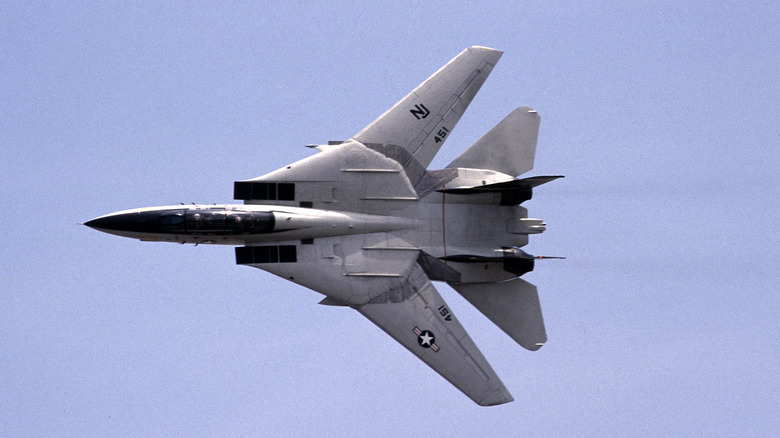What Does The Inside Of An F-14 Tomcat Fighter Jet Look Like?
One feature that stands out with the F-14 Tomcat is its cockpit built for two. It's not a common configuration on other fighter jets except on particular variants, specifically ones used for pilot training purposes, such as with the F-16 fighter jet family. That wasn't the case for the Tomcat, though. Speaking at the Armed Forces Air Show 1997, 25 years after the U.S. Navy received its first F-14s, Lieutenants Steve McShay and Dave Halprin of Fighter Squadron VF 101 explained why the Tomcat had to be controlled by two.
According to Lt. McShay, per EFP Network, "the F-14 ... has the most powerful airborne radar in a fighter you'll ever see, and probably may ever see again." To get the most out of its extensive functionality, then, the radar needs a crew member's constant monitoring, freeing up the pilot to concentrate exclusively on "keep[ing the F-14] up airborne and point it in the right direction."
Inside an F-14, then, is the aforementioned radar, which is concealed within the aircraft's pointed nose. Behind that are the front and aft cockpits. Each sports the range of sophisticated equipment that would be expected of such an aircraft, tailored to that crew member's specific role. Though the F-14 is now retired, it was certainly a force to be reckoned with during its tenure.
A two-seater cockpit that boasts a variety of clever tools
The Tomcat was a product of the Cold War, developed at a time when U.S. military assets like aircraft carriers and wider fleets were prominent targets for potential attacks by the Soviet Union. Born into this era of global uncertainty and fear of an attack from an opposing superpower, the Tomcat was created with both defense and offense in mind. That formidable radar, which could detect threats at a distance of more than 90 miles, was one of its biggest innovations. It's little surprise that an RIO, or radar intercept officer, was necessary. Their area was dominated by the AWG-9 Weapon System, with a primary and secondary screen.
Meanwhile, in the pilot's cockpit, there was a sophisticated ejector seat and a limited replica of the screen the RIO used. The famous warplane was equipped with a deadly arsenal of weaponry, from Phoenix missiles to General Electric's 20mm M61A-1 Vulcan. Thus equipped, it could pose a significant threat at any distance. The versatility of its weaponry was further boosted by having a RIO.
The RIO's job, just like that of the pilot, was a complicated one. In the above F-14 interior tour, via EFP Network, Lt. McShay summarizes, "... you see a myriad of switches. That's ... what's required to make this thing work." To make the best potential use of those weapons, the Tomcat was equipped with a sizable bubble canopy, giving the crew a great view of their surroundings.
